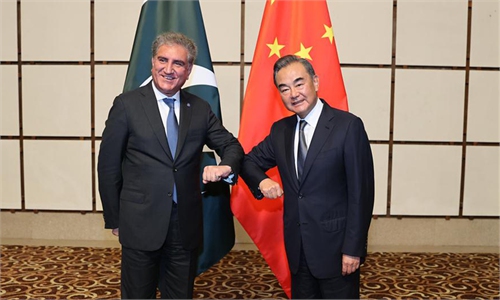COMMENTS / EXPERT ASSESSMENT
India's narrowing trade deficit with China is unsustainable

Illustration: Xia Qing/GT
In recent months, India has seen its trade deficit with China fall and then bounce back, demonstrating that any manufactured reduction in the trade deficit based on protectionism simply isn't sustainable, despite being the result Indian authorities are longing for.
India's exports to China surged 78.1 percent year-on-year in June, while its imports from China dropped 43.7 percent during the same period, leading its trade deficit with China to narrow to $1.2 billion from $2.4 billion in May, according to data from the Indian Department of Commerce.
The major reason was China's swift economic recovery from the fallout of the COVID-19 pandemic, which has driven up demand for resources and raw materials such as chemical products and ores - two of the goods typically imported from India to China.
Meanwhile, India, which has been drowning in continuously surging COVID-19 infection cases, has seen weakened demand for mechanical and electrical products, as well as manufactured goods, usually imported from China.
In addition to the lowered demand, India has been stoking tensions with China on economic and trade issues, by boycotting Chinese products, banning Chinese apps and restricting Chinese investments. These frayed bilateral economic ties have also dragged down India's import from China.
Regardless of India's efforts to drive down its imports from China, a scenario in which India sees increased exports and decreased imports from China couldn't last for long. In fact, its trade deficit with China had already bounced back to $3.84 billion in July, despite New Delhi showing no sign of wanting to ease economic tensions.
By comparison, India's exports to the US dropped 11.2 percent year-on-year in June. Its exports to the UK slid even further by negative 33.8 percent.
According to IMF estimations, China may be the only major economy realizing positive growth this year, while most developed economies like that of US, Japan and Canada may not be able to prevent a large contraction due to their ineffectiveness in dealing with the pandemic.
As China speeds along a path of rebooting its economic activities, its export sector will gradually resume momentum too. And if India keeps rolling out artificial restrictions on Chinese products, triggering any homogeneous counter moves, its economy won't be able to avoid the subsequent negative effects; not to mention the fact that India's reopening of economic activity alongside a worsening epidemic situation may bring further woes to its contracting economy.
At the prompting of the US, India, together with Australia and Japan, is promoting a so-called Supply Chain Resilience Initiative, aiming to reduce their dependence on China. Though it is an understandable wish, it is doubtful how effective the push is going to be. These three countries don't actually enjoy strong industrial complementarities. Although India offers a relatively cheap labor force and land, its insufficient infrastructure and unskilled labor cannot support large-scale industrial collaboration. Despite a similarly sized population, India cannot offer a market as attractive as China's, either.
Currently India is under great financial strain. It has been suggested that India should seek broader economic cooperation with China since the two countries have formed a certain degree of industrial interdependence. However Western economies, who have been struggling to deal with the pandemic, may not be willing to stump up extra capital to boost India's economy.
The author is the Director of Global Governance and Area Studies, Shenzhen University. bizopinion@globaltimes.com.cn



